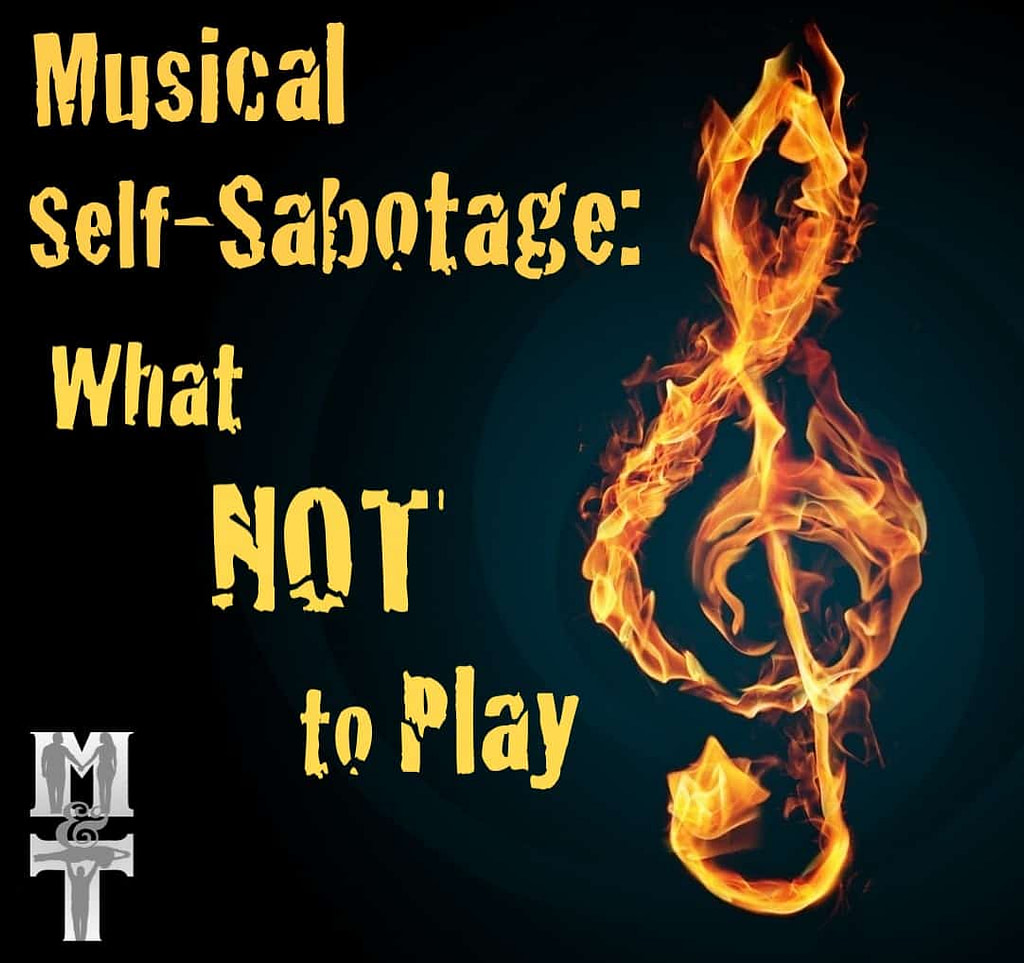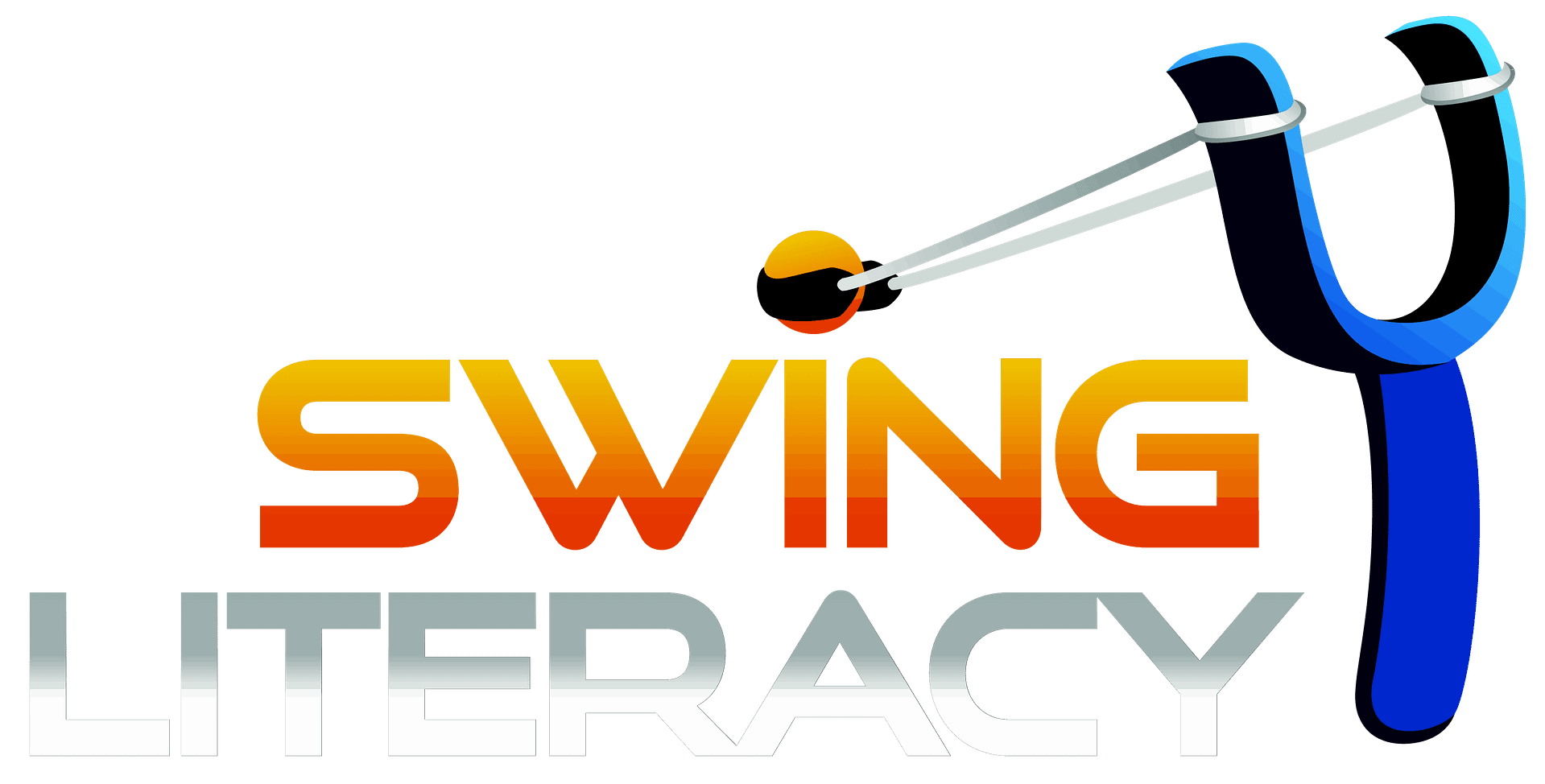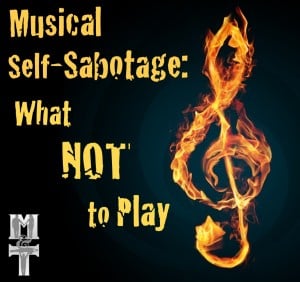No products in the cart.

Musical Self-Sabotage: What NOT to Play
Reading Time: minutes remaining
Are your music choices sabotaging your efforts to promote and develop West Coast Swing?
The wide range of music we can dance West Coast Swing to attracts a variety of demographics across generations, cultures, and tastes. But for anyone who plays WCS music, in trying to promote and cater to certain audiences, it is important to consider the needs of the consumer. The music you choose for demos, social dance parties, or classes often has a make-or-break impact.
This article is NOT:
- an instruction manual
- aimed at DJ’s in particular
- a definitive list of recommended songs
A Little Background Inspiration:
One of our regular students (not a teacher or DJ) hired us to teach a one-time WCS taster workshop at his university to 200 18-year-olds who as part of a 1st-year (freshman) orientation camp. We ran our signature introductory WCS class (very different from a traditional intro WCS class: for more info, see www.swingliteracy.com). They were super excited to be starting university and meeting new people – the room was just buzzing with youthful energy. But when it came time to put on music, our student put on a medium-tempo standard blues song from his personal WCS practice playlist. We gave him a look and he slapped his own forehead and switched songs immediately, realizing his mistake. It didn’t occur to him at first to check the genre of the song – he was only looking for a nice slow bpm the newbies could keep up with.
Let’s be very clear here: This is not a genre-battle. We like Blues. We endorse (good) Blues. We recommend beginners learn Blues…eventually. But it wasn’t appropriate in this circumstance. It doesn’t sell WCS to this demographic.
One of our regular students (not a teacher or DJ) hired us to teach a one-time WCS taster workshop at his university to 200 18-year-olds who as part of a 1st-year (freshman) orientation camp. We ran our signature introductory WCS class (very different from a traditional intro WCS class: for more info, see www.swingliteracy.com). They were super excited to be starting university and meeting new people – the room was just buzzing with youthful energy. But when it came time to put on music, our student put on a medium-tempo standard blues song from his personal WCS practice playlist. We gave him a look and he slapped his own forehead and switched songs immediately, realizing his mistake. It didn’t occur to him at first to check the genre of the song – he was only looking for a nice slow bpm the newbies could keep up with.
Let’s be very clear here: This is not a genre-battle. We like Blues. We endorse (good) Blues. We recommend beginners learn Blues…eventually. But it wasn’t appropriate in this circumstance. It doesn’t sell WCS to this demographic.
First impressions mean everything
Newbies form their impression of West Coast Swing the very first time they see it danced with sound. If they can’t connect to the music (and the dance models) immediately, their desire to try it is greatly diminished. I personally experienced this the first time I saw WCS: slow, awkward-moving people my parents’ age wobbling back and forth to sleepy, ride-a-horse Blues…I said, “pass”: I preferred Hustle and Jive.
In the beginning, brand new dancers listen to music as just music. As an end in itself, not a means to an end. As in karaoke and “American Idol”, they are engaged in the lyrics and the poetry, and appreciate the quality of the instruments and vocals. They decide if they know the song well enough to sing it. If they don’t know it, they tend to lose interest, unless it contains magnetic “hooks”. “Hooks” are the acoustically addictive elements that are common across all uber-popular songs. Studies have been done! In fact, here’s even a song that makes fun of them: Marianas Trench: Pop 101
New dancers are very sensitive to the music, because there’s no movement to distract them yet. But as people transition to becoming “dancers”, they focus less on the music and more on the movement, (and eventually have to retrain themselves to listen to the music, which is why Musicality classes are so popular!) As dancers gain experience, they learn to value the beat and rhythmic variety over the lyrical content. They seek out songs that challenge them physically, and they develop more sophisticated taste for phrasing, poetry, and mood. Beginners haven’t developed their taste for dance music yet- they don’t know what to look for in the music, they just feel an inspiration to move – to bop in their car, get up at a wedding reception, or groove awkwardly while holding their drink at the bar.
This is a great benchmark to gauge good songs to play for beginners, no matter the demographic: what would make them dance while alone in their car?
Consider your Audience
You really have to exercise “putting yourself in someone else’s shoes” when choosing music. We each have our own tastes – what turns my crank musically might “just tolerable” for you. Just because you like Rock music, doesn’t mean your WCS dance demo to it is going to inspire new dancers to sign up for their first class. You want to pick something that is going to appeal to the majority of the demographic you are aiming to attract.
Just to be clear, I am not pigeon-holing certain groups into musical tastes. In WCS, I have met aging hip hoppers who teach their grandkids how to pop-lock. I have taught a 30-year-old who was looking for a dance he could do to the Beatles, and I know a handful of teenaged dancers who are classical musicians. But these are exceptions, and we’re trying to play a game of mass appeal.
Playing to a youth or religious audience? Be extra sure to pre-screen your songs for explicit lyrics and sexual content, as these groups are more sensitive. Here’s a few examples of happy, clean, relatively current contemporary songs:
Taylor Swift: Blank Space
Mark Ronson/Bruno Mars: Uptown Funk
Jason Derulo: Want to Want Me
Ed Sheerhan: Sing
Trying to convince a Masters-aged friend they are not too old to learn to Swing dance? Be sure to show them video clips of Masters J&J prelims – they will get to see role models they can relate to dancing to a variety of different music. People tend to prefer music they remember from their youth, so here are a few favourite classics that might attract this generation:
The Commitments: Mustang Sally
Patti Austin: Ability to Swing
Blues Brothers: Sweet Home Chicago
James Brown: Get Up Offa That Thing
Amy Winehouse: Valerie
Criteria for beginners songs
- Upbeat, lighthearted, groovy songs
- Clear, uncluttered beat
- Predictable phrasing and breaks that are not too long
- 90-115bpm is the “goldilocks” tempo – juuust riiiight
Recommended songs to play for beginners in classes, comps, and social dancing:
Gym Class Heroes: Stereo Hearts
Robin Thicke: Blurred Lines
Rock Mafia: The Big Bang
Ed Sheeran: Don’t
John Mayer: Waiting on the World to Change
Pitfalls to Avoid
I’m going to mention some songs here, but I want to be clear that they are not bad songs, just might be a bad choice for the occasion.
Choosing Music for Classes
Play: Songs that vary in tempo, instrumentation, and genre
But Avoid: Late night gooey groove songs.
Examples:
Lorde: Royals
Brandy: Can You Hear Me Now
Unless it’s an advanced lyrical musicality class, students need a clear beat. No samba, no zouk, no fancy syncopated alternative rhythms. This does not mean the song has to be boring! Many dancers are blissfully unaware of the rhythmic complexity that our favourite WCS songs have. Veterans have trained themselves to either ignore it or enjoy it. Beginners however will be distracted by it in their mission to find their timing, so keep the beat straightforward and distinct.
Play: Songs that have a bit of a sexy R&B vibe
But Avoid: Songs that are too sexy, dark, or dramatic
Examples:
Trey Songz: Na Na
Outlandish: Callin U
Muse: Madness
Don’t get us wrong- WCS is a sexy, slinky dance and we love that side of it. But it is intimidating to dance virgins who are just learning to manage their own self-consciousness. Better to keep the mood more upbeat and less stressful, even for a slower bpm.
Play: Acoustic songs
But Avoid: Beatless songs (songs with no clear backbeat)
Example: Charlene Soraia: Wherever You Will Go
Dancers should be learning to “find the beat” with a variety of different instruments and sounds, but the acoustic songs that have either no backbeat or a silent “implied beat” are extremely difficult to manage your own timing. There is simply not enough audible confirmation that you are on time. Save those songs for more advanced dancers to challenge themselves with at the end of the night.
Play: Classic songs that may or may not have a swung rhythm
But Avoid: Songs that are in the grey area.
Example: Ex’s and Oh’s – Elle King
If you have a group of Lindy Hoppers who are crossing over to WCS, they are probably training in how to extract their bounce from their steps. Playing a really bouncy swung rhythm song in that overlapping zone between Lindy/East Coast Swing and WCS is only going to elicit more bounce.
Play: Familiar songs when teaching musicality
But Avoid: Unknown songs
I recently witnessed a high level dancer teaching a musicality workshop in which he was asking the dancers to step only on the words – great concept. But, he played one song that everyone knew, and everyone could really sink their teeth into the challenge. Then he played a second song no one knew and expected the same result. Everyone struggled and were left feeling frustrated. No matter how good that second song was, it was inappropriate for that exercise.
Choosing Music for Social Dance Parties
I’m not speaking to the convention crowd here – I’m aiming for the local regular dance party hosts – this might be a professional DJ, or a studio teacher, or just a dance enthusiast. The local dance scene has a large percentage of newer dancers who are working on dancing on time, but also “improvers”: dancers of any level who have been taking classes for a while and are working on their dance, striving to become more musical. Keep in mind that the newer dancers tend to populate the beginning of the dance party, and the more advanced dancers that can handle more challenging music will show up later in the evening.
Here are some pitfalls to avoid when choosing music for this type of crowd.
Play: A range of tempos between approx. 85bpm and 120bpm.
But Avoid: Ridiculously slow music.
Examples:
Marian Hill: One Time
Ed Sheerhan: I See Fire
WCS is a walking dance. A bpm higher than brisk walking pace looks frantic. A bpm slower than a stroll is painfully hard to keep your balance! I know many DJs take pride in finding unusual, challenging songs that set them apart, but you still need to cater to the customers. If you play a challenging slow song and look up to see that 90% of the room is off-time, that song is too slow for that crowd. People are struggling, which means they are failing at doing the things that make their dance enjoyable. You’re ruining their mojo. People have fun when they are successful. Your goal should be to provide dancers opportunities for success and occasional challenges, but that challenge is too much. If you really love the song, pitch it up.
Play: A variety of genres from global influences
But Avoid: Songs that aren’t WCS
Examples:
The Weeknd: Earned it
Sia: Elastic Heart
Major Lazer: Lean On
Hozier: Take Me To Church
As innovators, we like pushing boundaries, but we also have a respect for character of dance. WCS takes influence from many other dance styles, but that doesn’t mean it should be forced onto a song that has the dominant rhythm of another dance style. Example: Salsa is in 4/4 time: mathematically it is possible to dance WCS to a slower salsa song. But you wouldn’t want to because the latin rhythm is too dominant. The same can be said for Samba and Zouk. By playing these songs, dancers are forced to either dance off-time in order to match the rhythm, OR sacrifice their character of WCS. Neither choice is helpful. A great tester question is: “Is this a WCS song that you can also dance X to? Or is this an X song that you can also dance WCS to?”. Generally, reject the latter but will allow the former if it is a particularly good song.
Play: A variety of good non-contemporary songs: Blues, Funk, Soul, and Jazz
But Avoid: Bad Blues, or Blues just for Blues’ sake
Examples:
Microwave Dave & The Nukes: Roadrunner
Yes, Blues is the most significant original influence for our dance and still has a place in WCS. Has it diminished in value? No, I think it’s just that there are more genres competing for influence, which has diluted the pool. All good Westies should learn their roots in order to understand the source of their movement.
That being said, unless they grew up as musicians or around musicians, the average new dancer’s chance of having been exposed to Blues music in this generation is extremely minimal, which means they likely have not developed a taste for it. This means that, like it or not, the music being played at WCS dance parties is serving to educate these dancers on what Blues is and how to appreciate it. This is a great responsibility not to be taken lightly!
There are “Blues Standards” – songs that are universally known by every WCS dancer. Some are good, some are bad, and some are super-cheesy and overplayed. These are important to play to keep traditions alive but also so the community learns to recognize them in competition. Most of these are good quality But the major mistake we often see DJ’s make is playing Blues for Blues’ sake, but not being picky enough. But when DJs get bored of the Blues Standards and try to play something lesser known, they often choose songs that are not inspiring to dance to. This gives dancers the wrong impression of Blues and they get a bad taste in their mouth. It’s very hard to bring them back once they’ve made up their mind about Blues.
Sources for WCS Music
About WCS Music (our resource site)
Global Swing DJs
World Swing DJs Top 10
AllSwingDJ.com
USASwingNet.com
However, just as if you were shopping in the grocery store – just because they sell it doesn’t mean you have to buy it. Grocery stores sell healthy food but also a lot of junk food, so you have to use your discretion and think critically about the song suggestions before adding them to your own playlist. Hopefully this article will serve as your guide!
What happened to our University group?
We found them some 95bpm recognizable current pop music to practice to during class. Then after class was over, and we finished our demo and announcements, they snowballed into a social dance party. Our student kept DJing from his playlist, which was hit-and-miss. In the beginning, all the kids were super enthusiastic and were trying their moves with each other – it warmed our hearts! But then a dark, emotional song came on and the room died. The kids were wanting to stay and dance, but they weren’t inspired and didn’t get how to move to that music. They all stood around, swaying, chatting, suddenly self-conscious again where only 5 minutes earlier they were brimming with confidence and enthusiasm. The project was at risk! We quickly jumped in and modified the playlist to include only 95-115 bpm songs that were recognizable, upbeat, lively, grooving, and not blatantly sexy. The room brightened up again, even erupting in impromtu jam circles, and ended with an Uptown Funk finale. The Swing club collected 2 1/2 pages of email addresses from students wanting to sign up for lessons.


Great post! Really informative! I found myself wanting just a couple of examples in each category of “play” songs, though. Could you give 2-4 songs in each category that are go-to songs for you, just for a starting point? Thanks!
Joseph, this was already included in this article, in the “consider your audience” section. There are so many good examples out there, but the point of the article was to feature and explain the red light songs, not recommend green light songs.
Wonderful article with great details and examples. Thank you for sharing your knowledge Tessa!!!!
Great article! Agree wholeheartedly on your point of considering the audience for song selection. Too often, local DJs play as if their audience is an experienced, knowledgeable convention crowd and newcomers leave, uninspired.
What a cool article; great descriptions, examples and song links (some of which might need updating – since the links are not working)! I have definitely seen the situation you describe in your last paragraph (fortunately not at WCS too much but at other events) and applaud you for jumping in and applying dance party revival techniques to bring everyone back in again.
Links fixed! 🙂